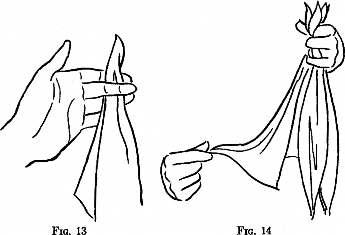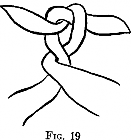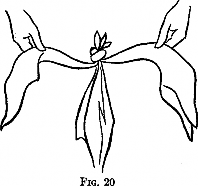
5. THE SYMPATHETIC SILKS
The trick in which knots are made to travel apparently from one set of silks to another was first described by Hatton and Plate in Magicians’ Tricks. Of recent years it has become a prime favorite with magicians generally. While there are many variations in detail, the effect remains the same.
Effect. The performer counts six large silk handkerchiefs one by one; he lays three aside and ties the other three together. The knots are ordered to pass from one set to the other and this is shown to have taken place. The knotted set is given to a spectator to untie the knots, to prove that they are genuine; then he ties them together again. The other set is then found to be tied in the same manner. Finally the spectator unties his set and the other set is also found to have become separated.
Articles required. Six large silks, at least eighteen inches square, all of the same color, the more striking the better; two small rubber bands; a fan; and two chairs.
Preparation. Tie three of the silks together with small double knots and arrange them as shown in Fig. 12; then put them together so that the knots are hidden in the folds. Place these with the other three over the back of a chair on your right, in such a way that you can pick up the three knotted silks at once without disturbing their arrangement. Lay the fan on the seat of the same chair and put one rubber band on the tip of each middle finger, the second being merely a reserve in case of accident.
Method. The six silks must first be placed in the left hand in such a way that they can be counted, apparently, as six separate silks. To do this pick up one silk and put it in the left hand, slipping the left middle finger in front as in Fig. 13. Take the three knotted silks, place the ends between the left third and fourth fingers, bend the second and third fingers in, and grip the ends between the forefinger and thumb; finally put the two remaining separate silks between the left thumb and forefinger.

To count them, take hold of one of the separate silks just below the left thumb with the right hand, run the hand down to the lower end, pull the silk away by that end, separate the hands about two feet, and count “One” (Fig. 14).

Take the top corner of the second separate silk, pull it away the same distance, and count “Two.” Hold these two silks as in Fig. 15.
Place the ends of these two between the thumb and forefinger of the left hand; grasp the ends of the three knotted silks with the right hand and draw them away, counting “Three.” Slip the right forefinger in front of them, so that they are held between the first and second fingers (Fig. 16).
Complete the count by taking the three singles, one by one, between the right thumb and forefinger, separating the hands each time and counting “Four, five, six.”
The count must be made at the same tempo throughout and there must be no hesitation at the moment when the two singles are substituted for the three knotted ones.


Take the three singles from between the right thumb and forefinger and place them over the right arm. Run the left hand down the other set to the middle, double them in half, and lay them on the seat of the chair at the right. Go over to the chair on the left; put one of the singles on the seat and show the other two, one in each hand, holding them about two inches from the top corners. These two must now be tied with a, false knot. Place the corner in the right hand crosswise over the corner in the left hand and hold both corners with the tip of the left thumb (Fig. 17). With the right hand turn the corner of the left-hand silk over the other under the left thumb tip (Fig. 18); then grasp the remaining corner and its silk with the right hand so that the two corners are looped together, pull them tightly, and then put the left thumb on the point of junction. In doing this simulate the action of tying a knot; really the corners are simply doubled one over the other. Now tie the corners with a single knot and pull it very tight (Fig. 19). Take hold of the opposite corner of one silk and let the two hang down; they will appear to be firmly tied, but a shake will cause them to fall apart.
Take the third silk from the chair and make the same false knot, attaching it to the upper one of the other two. Display the chain and lower the silks onto the seat of the chair. Explain what you are about to do—that is, to make the knots pass from one set of silks to the other—and with the fan pretend to waft them from one chair to the other. Then, without showing any result, pretend that you have succeeded and remark that it is much harder to send the knots back to their original positions. Fan again and lift the first silk of the set on the left-hand chair high enough to show the first knot; then let it fall back on the seat.
This pretense will arouse some laughter; so, to convince the audience that the knots really did pass, repeat the fan pantomime. Then seize the loose corner of the upper silk on the right-hand chair, jerk it upwards, and display the chain of knotted silks. Go to the other chair and jerk the silks there upwards, in the same way, and they fall apart.
Hand the knotted silks to a spectator and have him untie the knots to prove that they are genuine. While he is doing this, take the other three silks by the ends; slip the rubber band off your middle finger over the ends; and then gather them in a loose bundle in your right hand, holding the hand stretched out with the silks on its palm.

Instruct the spectator to take his three silks, now separate, by their ends; tie them together with a single knot and hold the other ends of two of them, with the third hanging down between them (Fig. 20). Toss your bundle in the air, catch the silks as they drop, and display them apparently tied in the same way. Bundle them up again, seizing the opportunity of slipping the rubber band off, and place them on the seat of one of the chairs. Retrieve the knotted silks from the spectator, openly untie the knot holding them together, and order the set on the chair to follow suit. Lift these one by one and show the magic has worked.
The trick comes to a natural conclusion at this point; the climax has been reached and the effect has not been overdone. But some performers continue by apparently tying all six by means of another rubber band, then again showing them separate, and so on. These additions drag out the trick too much and increase the danger of discovery of the means employed. It is a wise magician who knows when to stop.
Website Content: © Copyright 2024 by Trickshop.com.